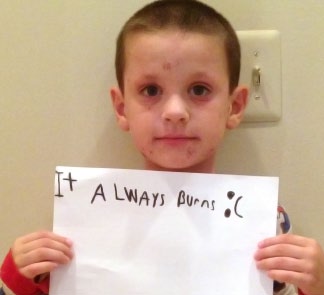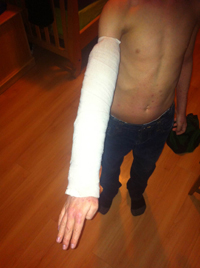Eczema Treatment For Children

With a good regimen of bathing, moisturizing and prescription medications (if needed), you can help your child be more comfortable
There is no one “right” treatment for eczema in children. What works for another child may not work for yours. You may have to go through several treatments or combinations of treatments in partnership with your doctor before you find one that helps manage your child’s symptoms. Be persistent and patient as treating eczema can take several weeks or longer before you see real progress.
Bathing and moisturizing
It is important to have a regular schedule with eczema care that includes bathing with a gentle cleanser and moisturizing to lock water into the skin. Moisturized skin helps control flares by combatting dryness and keeping out irritants and allergens.
The “Soak and Seal” method of treating eczema is recommended by many providers to help dry skin and reduce flares. To get the full therapeutic benefit, have your child Soak and Seal often and follow these steps in order.
Instructions to Soak and Seal
- Put the child in a bath using lukewarm water for five to 10 minutes. Use a gentle cleanser (no soaps) and avoid scrubbing the affected skin.
- After bathing, pat the skin lightly with a towel leaving it slightly damp.
- Apply prescription topical medication to the affected areas of skin as directed.
- Within three minutes, liberally apply a moisturizer all over the child’s body. It important to apply the moisturizer within three minutes or the skin may become even drier.
- Wait a few minutes to let the moisturizer absorb into the skin before dressing or applying wet wraps.
Don’t limit moisturizing to just bath time. Slather it on your child throughout the day whenever their skin starts to itch or feel dry. Try using an ointment or a cream rather than a lotion and apply it with your palms, stroking lightly in a downward direction.
Bleach Baths
Bleach baths can be an effective tool to reduce inflammation and bacteria on the skin of children with eczema. The concentration of bleach in the bath is about that of a chlorinated swimming pool.
Download our bleach bath instruction sheet.
The American Academy of Dermatology encourages parents to do the following when giving their child a bleach bath:
- Use a measuring cup to get the exact amount of bleach needed and then add it to the water. Too much bleach may irritate the child’s skin and too little may not help eczema symptoms.
- Never apply bleach directly to the child’s eczema.
- Talk to your dermatologist about starting bleach bath therapy including how long your child should soak. Most dermatologists recommend 5 to 10 minutes per bathing session, according to the American Academy of Dermatology.
Parents of children with bleach sensitivities or allergic asthma that might be aggravated by chlorine fumes should consult with their heath care provider before starting bleach bath therapy.
Learn more about bleach and other types of bath additives that help the symptoms of eczema.
Wet wrap therapy
During particularly intense flares with severe itch or pain, wet wrap therapy can rehydrate and calm the skin and boost the effectiveness of topical medications.
Wet wraps are best done in the evening after bathing, moisturizing and applying medication.
Get detailed instructions on how to do wet wrap therapy on your child.
Over-the-counter remedies
Your doctor may recommend treatments available for purchase at your local drug store, including gentle cleansers, mild corticosteroids, moisturizers, petroleum jelly, mineral oil or tar-based products. There are many OTC products available that may help prevent and control eczema symptoms in your child.
Visit our directory of over-the-counter products that have received the National Eczema Association Seal of Acceptance™ to find a treatment that works for your child.
Prescription treatments
Topical medications
Topical medications are applied to the skin. There are four forms of prescription topicals approved to manage symptoms of eczema.
Learn more about topical treatments.
Phototherapy
Also known as light therapy, phototherapy exposes the skin to a special type of light called ultraviolet B (UVB) using a walk-in machine.
Learn more about phototherapy.
Immunosuppressant medications
Used for moderate to severe cases of eczema, immunosuppressants work by controlling or suppressing, the immune system. Immunosuppressants prescribed “off-label” meaning that the FDA has not approved them for use with eczema. However, they are commonly used by doctors to treat difficult eczema cases.
Learn more about immunosuppressant medications.
Biologics
Biologic drugs or “biologics” are genetically engineered from proteins derived from living cells or tissues. They are designed to target specific parts of the immune system that contribute to chronic inflammatory diseases such as atopic dermatitis.
Dupixent (dupilumab) is the first biologic medication approved by the U.S. Food and Drug Administration (FDA) for children aged 6 years and up with moderate to severe atopic dermatitis for whom topical treatments have not worked or are not advised.
Dupixent is taken by subcutaneous (under the skin) injection every other week after an initial loading dose and is available by prescription only. For more information, visit www.dupixent.com and see our FAQ’s.
Complementary and alternative treatments
There are several natural treatments that have been shown to be effective controlling eczema symptoms. Many of these studies looked the effects on adults, so be sure to consult with your child’s doctor prior to starting any natural treatments for eczema.
Learn more about complementary and alternative treatments for eczema.


